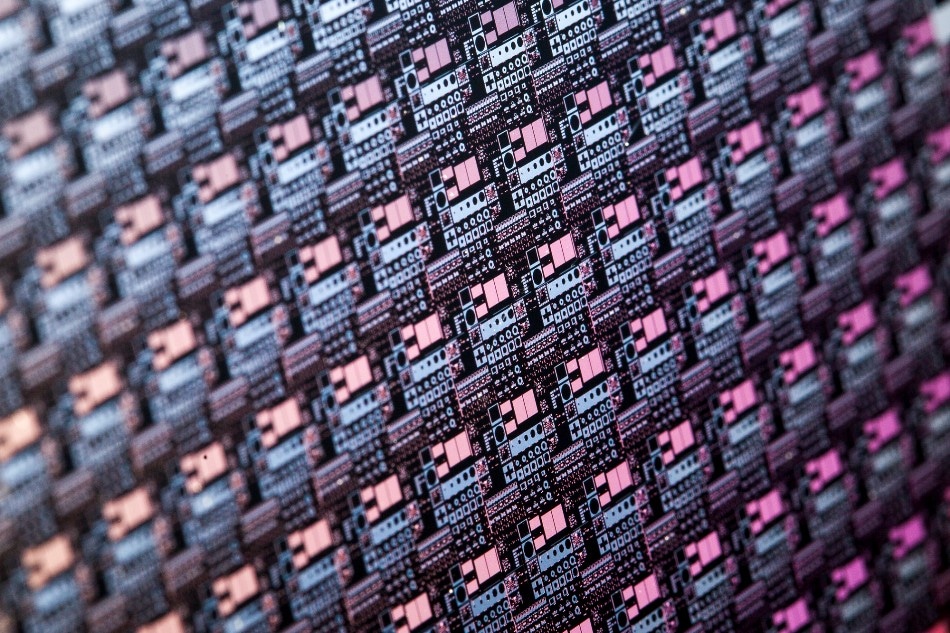Jan 22 2019
There is a steady growth in the electronics market and also in the demand for more and more efficient and compact power electronic systems. The main electronic components based on silicon will no longer be able to fulfill the rising industrial requirements in the projected future.
 Fraunhofer IAF develops electronic components and systems based on GaN. The image shows a processed GaN wafer. (Image Credit: Fraunhofer IAF)
Fraunhofer IAF develops electronic components and systems based on GaN. The image shows a processed GaN wafer. (Image Credit: Fraunhofer IAF)
On these grounds, researchers from the University of Freiburg, the Sustainability Center Freiburg, and the Fraunhofer-Gesellschaft have worked together to discover a new material structure that may be ideal for future power electronics. The recently launched project “Research of Functional Semiconductor Structures for Energy Efficient Power Electronics” (“Power Electronics 2020+” in short) studies the new semiconductor material scandium aluminum nitride (ScAlN). The supra-regional collaboration is coordinated by Prof. Dr Oliver Ambacher, director of Fraunhofer IAF and professor of power electronics at the Department of Sustainable Systems Engineering (INATECH) of the University of Freiburg.
The automation and digitalization of the industry and the growing awareness of sustainable processes and ecological responsibility are the three main factors responsible for the steadfast growth of the electronics market. It can be possible to reduce power consumption only if electronic systems become more resource-efficient, more energy-efficient, and more powerful simultaneously.
Silicon Technology Reaches its Physical Limit
Until now, silicon leads the electronics industry. Since silicon has an almost perfect crystal structure, is comparatively low in cost, and has a bandgap that allows for a good charge carrier concentration and velocity as well as a good dielectric strength, it has become a specifically successful semiconductor material. However, silicon electronics slowly reaches its physical limit. Particularly, while taking the required power density and compactness into account, silicon power electronic components are unsatisfactory.
Innovative Material Composition for More Power and Efficiency
The use of gallium nitride (GaN) as a semiconductor in power electronics has already overcome the drawbacks of silicon technology. When compared to silicon, the performance of GaN is better under the conditions of high temperatures, fast switching frequencies, and high voltages. This is closely related to considerably higher energy efficiency—with several energy-consuming applications, this implies a considerable reduction in energy consumption. For several years, Fraunhofer IAF has been studying GaN as a semiconductor material for electronic components and systems. With assistance from industrial partners, the outcomes of these studies have already been put to commercial use. The researchers of the project “Power Electronics 2020+” will take further steps to improve the durability and energy efficiency of the next generation of electronic systems once again. A new and different material known as scandium aluminum nitride (ScAlN) will be used for this purpose.
First Components Based on ScAlN
ScAlN is a piezoelectric semiconductor material with a high dielectric strength, which is mostly unexplored globally in relation to its usability in microelectronic applications.
The fact that scandium aluminum nitride is especially well suited for power electronic components, due to its physical properties, has already been proven.
Dr -Ing. Michael Mikulla, Project Manager, Fraunhofer IAF.
The objective of the project is to grow lattice-matched ScAlN on a GaN layer and to use the ensuing heterostructures to process transistors with high current-carrying capacity.
Functional semiconductor structures based on materials with a large bandgap, such as scandium aluminum nitride and gallium nitride, allow for transistors with very high voltages and currents. These devices reach a higher power density per chip surface as well as higher switching speeds and higher operating temperatures. This is synonymous with lower switching losses, higher energy efficiency and more compact systems.
Dr Oliver Ambacher, Professor and Director, Fraunhofer IAF.
By combining both materials, GaN and ScAlN, we want to double the maximal possible output power of our devices while at the same time significantly lowering the energy demand.
Dr -Ing. Michael Mikulla, Project Manager, Fraunhofer IAF.
Pioneering Work in Materials Research
Crystal growth is one of the greatest challenges of the project, taking into account the fact that till date, there are neither growth recipes nor empirical values for this material. It is necessary for the project team to develop these during the next months to achieve reproducible results and to develop layer structures that can successfully be employed for power electronic applications.
Specialist Collaboration and Knowledge Transfer Between Freiburg and Erlangen
The research project will be executed in close partnership with the University of Freiburg, the Fraunhofer Institute for Applied Solid State Physics IAF, the Sustainability Center Freiburg, and the Fraunhofer Institute for Integrated Systems and Device Technology IISB in Erlangen, which is a member of the High-Performance Center for Electronic Systems in Erlangen. This new form of partnership between university research and application-oriented development shall serve as a paradigm for future project collaboration.
On the one hand, this model facilitates the cooperation with companies through the prompt transfer of results from basic research to application-oriented development. On the other hand, it opens up synergies between two technically complementary Fraunhofer Centers from two different regions and thus improves both their offers for potential customers of the semiconductor industry.
Dr Oliver Ambacher, Professor and Director, Fraunhofer IAF